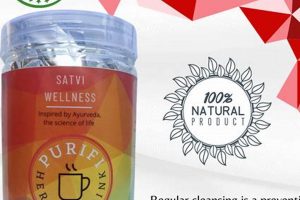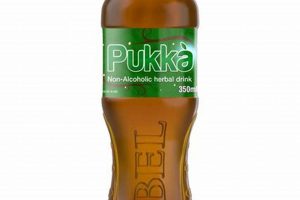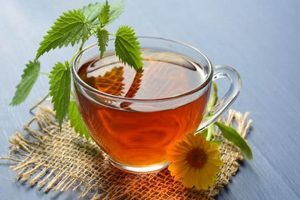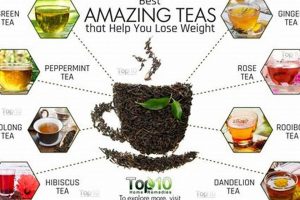Hydration is essential for human health, primarily achieved through water consumption. Herbal teas, infusions derived from plants other than Camellia sinensis (true tea), are often considered as a beverage choice. However, the degree to which they contribute to hydration similarly to water requires careful consideration. For example, while a cup of chamomile tea may seem hydrating, its diuretic effects might influence the net hydration outcome differently than a glass of plain water.
The importance of adequate fluid intake for bodily functions is well-documented, influencing processes from temperature regulation to nutrient transport. Herbal teas, in addition to providing fluid, may offer other benefits attributed to the specific herbs used. Historically, various cultures have used herbal infusions for medicinal purposes, recognizing their potential therapeutic properties. The hydrating capacity of these infusions, when devoid of added sugars or stimulants, can complement overall fluid intake and potentially contribute to well-being.
This article will explore the composition of various herbal teas, analyzing their potential diuretic effects, and comparing their hydrating capabilities to those of plain water. Furthermore, it will examine the impact of additives, such as sweeteners or caffeine, on the overall hydration potential. Finally, consideration will be given to the role of herbal teas within a balanced hydration strategy.
Considerations for Fluid Intake with Herbal Infusions
Maximizing hydration through herbal tea consumption requires informed choices and mindful practices. The following guidelines offer a framework for integrating herbal infusions into a hydration regimen.
Tip 1: Prioritize Water as the Primary Hydration Source: Water should remain the foundation of daily fluid intake. Herbal teas can supplement this, but should not be the sole source of hydration.
Tip 2: Opt for Unsweetened Herbal Teas: Added sugars can negate some of the health benefits and may contribute to dehydration. Choose herbal teas without added sweeteners.
Tip 3: Be Mindful of Diuretic Effects: Certain herbs, such as dandelion or hibiscus, possess diuretic properties. Monitor individual responses and adjust intake accordingly.
Tip 4: Choose Herbal Teas Wisely: Different herbs have varying compositions and potential effects. Research the properties of the specific herbs before incorporating them into a regular routine.
Tip 5: Maintain a Balanced Hydration Strategy: Combine herbal tea consumption with other sources of fluids, such as water-rich fruits and vegetables, to ensure adequate hydration.
Tip 6: Consider the Temperature of the Tea: Both hot and iced herbal teas can contribute to hydration. Choose the temperature that is most appealing to facilitate increased consumption.
Tip 7: Monitor Urine Color: Urine color serves as an indicator of hydration status. Aim for a pale yellow color, indicating adequate fluid intake.
By implementing these strategies, individuals can leverage the potential benefits of herbal teas while maintaining optimal hydration levels. Careful consideration of herbal properties and mindful consumption are essential.
The subsequent sections will delve deeper into the specific components of herbal teas and their impact on overall health and well-being.
1. Hydration effectiveness
Hydration effectiveness, concerning the question of whether herbal infusions provide hydration equivalent to water, is a multifaceted consideration. The efficiency with which a beverage replenishes bodily fluids and maintains electrolyte balance dictates its hydrating capacity. Several factors contribute to this effectiveness, determining if replacing water with herbal tea offers comparable hydration.
- Osmolality and Electrolyte Balance
Osmolality, the concentration of dissolved particles in a fluid, influences the rate of absorption in the digestive tract. Water has a low osmolality, facilitating rapid absorption. Herbal teas, depending on the ingredients and preparation method, may have varying osmolality levels. The presence of electrolytes, such as sodium and potassium, in a beverage also affects its ability to promote fluid retention. Plain water lacks electrolytes, whereas some herbal teas may contain trace amounts, potentially aiding in hydration, particularly after exertion. However, excessive osmolality can draw water into the digestive tract, reducing hydration effectiveness.
- Diuretic Properties of Herbs
Certain herbs possess diuretic properties, promoting increased urine production. Dandelion, hibiscus, and parsley are examples of herbs with diuretic effects. While fluid is being ingested through the tea, the diuretic action can lead to a net loss of fluid, reducing hydration effectiveness. If an herbal tea has strong diuretic properties, the fluid consumed may be excreted more rapidly than if plain water were consumed. Understanding the diuretic potential of specific herbs is crucial when assessing the hydration benefits of herbal teas.
- Rate of Absorption
The speed at which the body absorbs fluid from a beverage directly impacts its hydrating capability. Water is absorbed relatively quickly in the small intestine. The presence of certain compounds in herbal teas, such as tannins or complex carbohydrates, might slightly slow down the absorption rate compared to water. This could lead to a slower, more sustained release of fluid into the bloodstream, but can also negatively affect initial hydration needs. The overall volume of fluid absorbed over a specific time is a key factor in assessing hydration effectiveness.
- Impact of Additives
Additives in herbal teas, such as sweeteners or caffeine (found in some tea blends despite being considered “herbal”), can significantly affect hydration. Sugary additives increase osmolality, potentially hindering absorption and promoting dehydration. Caffeine is a known diuretic, exacerbating fluid loss. Unsweetened and caffeine-free herbal teas more closely mimic the hydrating properties of water. However, the presence of these additives transforms the beverage’s hydrating profile.
Assessing the hydration effectiveness of an herbal tea compared to water requires considering osmolality, electrolyte content, diuretic properties, absorption rate, and the presence of additives. While some herbal teas can contribute to hydration, the aforementioned considerations distinguish them from the baseline of plain water consumption. Therefore, the equivalence of hydration relies heavily on the specific tea composition and the individual’s physiological response.
2. Herbal composition
The botanical makeup of an herbal infusion profoundly influences its hydrating properties, thus impacting its similarity to water. The diverse chemical constituents within various herbs can either enhance or diminish the beverage’s capacity to replenish fluids effectively. Considering the wide array of available herbal teas, understanding their compositional differences is crucial when evaluating their hydrating potential in relation to plain water. Certain compounds present naturally in herbs, such as polysaccharides and electrolytes, contribute positively to water retention and cellular hydration. Conversely, other constituents, including specific organic acids and volatile oils, can exert diuretic effects, thereby reducing the overall hydrating capacity. For instance, herbal teas containing high concentrations of potassium can aid in electrolyte balance, promoting fluid retention within cells, which mirrors the hydrating effects of water. Conversely, teas rich in compounds like arbutin, found in bearberry, exhibit notable diuretic action, negating a portion of the fluid ingested.
Furthermore, the processing methods applied to herbs during tea production also impact their composition and subsequent hydrating effect. Drying, fermentation, and extraction techniques can alter the concentration of active compounds and modify their bioavailability. For example, steaming herbs during processing might reduce the volatile oil content, thereby diminishing any potential diuretic effects, or roasting herbal can create chemical changes to affect its properties. Thus, the final composition of an herbal tea is a result of both the herb’s inherent properties and the processing applied during manufacturing. Selecting herbal tea blends with a demonstrated balance of hydrating and non-diuretic components represents a crucial step in maximizing the hydrating benefits. Practical application of this knowledge involves a careful review of tea ingredients and an awareness of individual physiological responses to different herbal formulations.
In conclusion, the herbal composition serves as a determining factor in whether an herbal tea approximates the hydrating effect of water. A nuanced understanding of specific herbal constituents and their physiological effects, coupled with informed selection of herbal tea blends, is essential. However, challenges arise from the variability in herbal quality, processing inconsistencies, and individual metabolic differences. Despite these challenges, prioritizing herbal teas with known hydrating properties and minimal diuretic action remains a prudent strategy for supplementing water intake and promoting overall hydration. Further research into specific herbal compounds and their influence on fluid balance is warranted to fully elucidate this complex relationship.
3. Diuretic potential
The diuretic potential of herbal teas significantly influences their capacity to hydrate the body comparably to water. Diuretics promote increased urine production, potentially leading to a net fluid loss that counteracts the intended hydrating effect. This inherent property within certain herbs requires careful consideration when evaluating herbal teas as a primary source of hydration.
- Mechanisms of Diuretic Action
Herbal diuretics operate through various physiological mechanisms, primarily affecting kidney function. Some herbs, like dandelion and juniper, contain compounds that inhibit the reabsorption of sodium and chloride in the kidneys. This inhibition leads to increased excretion of these electrolytes, accompanied by water. Other herbs, such as parsley, increase glomerular filtration rate, resulting in a higher volume of urine production. The specific mechanism dictates the intensity and duration of the diuretic effect, consequently affecting the overall hydration balance when consuming the herbal tea.
- Common Diuretic Herbs in Teas
Many commercially available herbal teas contain herbs known for their diuretic properties. Dandelion leaf, a common ingredient, is often included for its purported detoxifying effects but can lead to increased urination. Green tea, though technically not an herbal tea, contains caffeine, a mild diuretic. Hibiscus, frequently used for its vibrant color and tart flavor, also possesses diuretic properties. Regular consumption of teas containing these ingredients may not provide hydration equivalent to water due to the enhanced fluid excretion.
- Impact on Electrolyte Balance
Diuretics not only increase water excretion but also affect electrolyte levels in the body. Excessive loss of electrolytes, such as sodium, potassium, and magnesium, can disrupt crucial bodily functions, including nerve and muscle function. Some herbal diuretics exert a “potassium-sparing” effect, minimizing potassium loss, but others can lead to significant electrolyte imbalances if consumed in large quantities or by individuals with pre-existing kidney conditions. Maintaining electrolyte balance is essential for proper hydration, and the diuretic effects of certain herbal teas can compromise this balance.
- Individual Variability and Considerations
The diuretic response to herbal teas varies among individuals based on factors such as age, kidney function, and overall health status. Individuals with impaired kidney function are more susceptible to the dehydrating effects of diuretic herbs. Similarly, older adults, who often have reduced thirst sensation and decreased kidney function, may experience greater fluid loss. Hydration needs and the potential impact of diuretic herbs should be carefully assessed on an individual basis to determine the appropriateness of using herbal teas as a primary hydrating beverage.
In summary, the diuretic potential inherent in many herbal teas distinguishes them from plain water in terms of hydration effectiveness. While herbal teas can contribute to fluid intake, their diuretic effects can counteract the hydrating benefits, potentially leading to a net fluid loss and electrolyte imbalance. Therefore, individuals should be mindful of the herbal composition of teas and consider their individual health status when incorporating them into a hydration strategy.
4. Additive effects
The inclusion of additives in herbal teas alters their hydration properties, thereby influencing whether consuming them provides an equivalent hydrating effect to drinking water. The presence of various additives can impact the osmolality, diuretic potential, and overall health benefits of the beverage, differentiating it from the neutral hydrating profile of plain water.
- Sweeteners
The addition of sweeteners, such as sucrose, fructose, or artificial substitutes, increases the osmolality of herbal teas. Elevated osmolality can hinder fluid absorption in the small intestine, drawing water into the digestive tract and potentially reducing the overall hydrating effect. Moreover, the metabolic processing of sugars requires additional water, further diminishing the tea’s hydrating capacity. Excessive sugar intake can also contribute to dehydration over time due to its impact on blood sugar levels and kidney function. Consequently, sweetened herbal teas are less effective at providing pure hydration compared to water.
- Caffeine
While most herbal teas are naturally caffeine-free, some blends may contain caffeine derived from sources like green tea or guarana. Caffeine acts as a mild diuretic, promoting increased urine production and potentially leading to fluid loss. This diuretic effect counteracts the hydrating potential of the tea, resulting in a lower net hydration gain compared to water. Even small amounts of caffeine can influence fluid balance, particularly in individuals sensitive to its effects. Therefore, caffeinated herbal teas may not offer the same level of hydration as plain water.
- Artificial Flavors and Preservatives
Artificial flavors and preservatives, often added to enhance the taste and shelf life of herbal teas, can have indirect effects on hydration. Some artificial additives can irritate the digestive system, leading to increased fluid loss through diarrhea or vomiting. Others may alter gut bacteria composition, potentially affecting nutrient absorption and hydration status. Furthermore, the long-term health effects of certain artificial additives remain a concern, potentially influencing overall well-being and indirectly affecting hydration balance. Plain water, devoid of these artificial substances, avoids these potential complications.
- Acidity Regulators
The inclusion of acidity regulators, such as citric acid, can impact the overall pH balance of herbal teas. High acidity may affect the absorption rate of fluids in the digestive tract and, in some individuals, can lead to gastrointestinal discomfort. Although the effect on hydration is not as direct as with sweeteners or caffeine, excessive acidity may alter the way the body processes the fluid, potentially reducing its hydrating efficiency compared to plain water, which has a neutral pH.
The presence of these additives differentiates herbal teas from water in terms of their hydrating effects. While herbal teas can contribute to fluid intake, the additives they contain can influence the net hydration benefit, making them not entirely equivalent to water. Choosing unsweetened, caffeine-free, and naturally flavored herbal teas minimizes the potential negative impact of additives on hydration and overall health.
5. Nutrient contribution
The nutrient contribution of herbal teas distinguishes them from plain water, affecting their overall role in hydration and well-being. While water primarily serves as a solvent and transport medium, herbal teas can provide a range of micronutrients and bioactive compounds. This nutritional aspect alters the equation of whether consuming herbal tea mirrors the simple hydrating function of drinking water. The addition of vitamins, minerals, and antioxidants from herbs transforms the beverage from a mere hydrator to a potential source of supplementary nutrition. For example, certain herbal teas, such as rooibos, contain minerals like iron, potassium, and calcium, essential for various physiological processes. These minerals contribute to electrolyte balance and cellular function, indirectly supporting hydration by facilitating fluid retention. Similarly, many herbal teas are rich in antioxidants, compounds that combat oxidative stress and cellular damage. These antioxidants, such as flavonoids and polyphenols, may have systemic health benefits beyond simple hydration, providing a broader spectrum of physiological support. However, the concentration of these nutrients in herbal teas varies significantly depending on the type of herb, growing conditions, and preparation methods. Therefore, the nutritional value of herbal tea is not uniform and cannot be consistently relied upon as a primary source of essential nutrients.
The practical significance of the nutrient contribution lies in its potential to complement dietary intake and address specific nutritional needs. For instance, individuals with limited access to nutrient-rich foods might benefit from the micronutrients provided by certain herbal teas. Similarly, those seeking to increase their antioxidant intake could incorporate antioxidant-rich herbal infusions into their daily routine. However, it is crucial to acknowledge that the nutrient contribution of herbal teas is generally modest compared to whole foods or targeted supplements. The bioavailability of nutrients in herbal teas can also be a limiting factor, as some compounds may not be readily absorbed by the body. Furthermore, the presence of antinutrients, such as tannins, in some herbal teas can interfere with the absorption of other essential minerals, potentially negating some of the nutritional benefits. Real-life examples include the use of ginger tea to alleviate nausea, a dual benefit of hydration and symptom relief, or chamomile tea’s calming effects, attributed to its bioactive compounds, alongside its hydrating properties.
In conclusion, the nutrient contribution of herbal teas sets them apart from plain water, adding a layer of complexity to their hydrating role. While water primarily serves to replenish fluids, herbal teas offer a supplementary source of micronutrients and bioactive compounds. The extent of this contribution depends on the specific herbs used, the preparation method, and individual absorption capacities. Despite the potential benefits, the nutritional value of herbal teas should not be overemphasized, as they are unlikely to serve as a primary source of essential nutrients. Instead, they should be considered as a complementary addition to a balanced diet, providing hydration alongside modest nutritional benefits. Further research is warranted to fully elucidate the bioavailability of nutrients in herbal teas and their long-term impact on health and hydration.
6. Absorption rate
The rate at which the body absorbs fluids significantly influences whether herbal tea provides the same hydrating effect as water. Absorption rate impacts how quickly fluid becomes available to cells, thereby determining the immediacy and effectiveness of rehydration.
- Osmolality and Gastric Emptying
Osmolality, referring to the concentration of dissolved particles in a liquid, affects gastric emptying rate. Water, having low osmolality, typically empties from the stomach more rapidly than solutions with higher osmolality. Herbal teas, depending on their composition and the presence of additives like sugars, can have varying osmolalities. Slower gastric emptying can delay fluid absorption into the small intestine, influencing the speed with which hydration occurs. High osmolality, common in sweetened herbal teas, may reduce the absorption rate compared to plain water.
- Influence of Herbal Compounds
Specific compounds within herbal teas can affect the absorption rate in the digestive tract. Tannins, present in some herbs, can bind to proteins and minerals, potentially slowing down their absorption. Other complex carbohydrates or fibers may also modulate the rate at which fluid is absorbed from the small intestine. These compounds alter the absorption kinetics compared to the relatively unimpeded absorption of plain water, potentially delaying or reducing the immediate hydrating effect.
- Intestinal Transit Time
The transit time of fluid through the intestines influences the overall absorption rate. Factors such as gut motility and the presence of dietary fiber can affect intestinal transit time. Herbal teas that contain compounds promoting faster gut motility may reduce the time available for fluid absorption, leading to less efficient hydration. Conversely, slower intestinal transit may enhance fluid absorption but delay the onset of hydration. These dynamic interactions affect the extent to which herbal teas can replicate the rapid hydration provided by water.
- Impact of Temperature
Fluid temperature influences the rate of absorption. Beverages consumed at body temperature are generally absorbed more quickly than those that are excessively hot or cold. Drinking very hot herbal tea may cause transient vasoconstriction in the digestive tract, potentially slowing absorption. Similarly, consuming very cold herbal tea may induce a similar response. Water consumed at a moderate temperature typically experiences a more consistent and rapid absorption rate compared to temperature extremes in herbal teas.
The absorption rate of herbal tea relative to water is thus modulated by factors including osmolality, the presence of specific herbal compounds, intestinal transit time, and beverage temperature. These elements collectively dictate the speed and efficiency of fluid absorption, thereby differentiating herbal teas from plain water in their immediate hydrating capacity.
7. Individual variations
The assertion of whether herbal tea provides hydration equivalent to water is significantly qualified by individual physiological differences. Metabolic rate, kidney function, hormonal balance, and pre-existing health conditions critically influence how individuals process fluids and react to specific herbal compounds. For instance, an individual with impaired kidney function may experience reduced capacity to regulate fluid and electrolyte balance, increasing susceptibility to dehydration from diuretic herbs. Conversely, a highly active individual with efficient metabolism may tolerate and utilize the micronutrients in herbal teas more effectively, potentially enhancing hydration beyond simple water consumption. Genetic predispositions can further shape individual responses to herbal teas, impacting absorption rates, metabolic pathways, and sensitivity to bioactive compounds. This inherent variability necessitates personalized approaches to hydration, rendering blanket statements about the equivalence of herbal tea and water inaccurate.
Consider the practical example of two individuals, one with diagnosed hypertension and the other without any cardiovascular issues. The hypertensive individual, often prescribed diuretics, may find that certain herbal teas containing diuretics, like hibiscus, exacerbate fluid loss, negating their hydrating properties and potentially disrupting medication efficacy. In contrast, the individual without hypertension may experience no significant adverse effects from hibiscus tea, benefiting from its mild diuretic action and antioxidant properties. Furthermore, individuals with specific allergies or sensitivities to herbal constituents may experience adverse reactions, such as gastrointestinal distress or skin irritation, which can negatively impact hydration status by inducing fluid loss or reducing overall fluid intake. The effects of age also play a crucial role. Older adults typically have reduced thirst sensation and diminished kidney function, making them more vulnerable to dehydration from diuretic herbs and highlighting the importance of carefully monitored fluid intake, personalized to their specific needs.
In conclusion, the concept of equating herbal tea with water for hydration purposes is contingent upon a spectrum of individual variations. Physiological factors, genetic predispositions, and pre-existing health conditions modulate how the body responds to herbal teas, altering their hydrating potential. While herbal teas can contribute to overall fluid intake and may offer additional micronutrients, their equivalence to water is neither guaranteed nor universally applicable. Personalized hydration strategies, considering individual needs and responses to specific herbal constituents, are essential for optimizing fluid balance and promoting overall health. Therefore, generalizations regarding the hydrating capacity of herbal teas should be viewed with caution, emphasizing the significance of individual assessment and tailored recommendations.
Frequently Asked Questions
The following questions and answers address common inquiries regarding the hydration equivalence of herbal tea and water, providing factual insights based on physiological and compositional considerations.
Question 1: Does herbal tea hydrate the body as effectively as plain water?
While herbal tea contributes to fluid intake, it is not entirely equivalent to water due to potential diuretic effects, varying osmolality, and the presence of additives. Water is absorbed rapidly and efficiently, serving as the baseline for hydration.
Question 2: Can herbal teas with diuretic properties lead to dehydration?
Yes, herbal teas containing diuretic herbs, such as dandelion or hibiscus, can promote increased urine production, potentially leading to fluid loss that counteracts the hydrating benefit. Regular consumption of such teas may not provide optimal hydration.
Question 3: Do sweetened herbal teas hydrate as well as unsweetened versions?
No, sweetened herbal teas have higher osmolality, which can hinder fluid absorption and even draw water into the digestive tract. Unsweetened herbal teas are preferable for hydration.
Question 4: Does the temperature of herbal tea affect its hydrating capacity?
Extremely hot or cold herbal teas may cause transient vasoconstriction in the digestive tract, potentially slowing absorption. Consuming herbal tea at a moderate temperature supports more consistent fluid uptake.
Question 5: Can herbal teas provide essential nutrients that water cannot?
Yes, certain herbal teas contain micronutrients and antioxidants, offering supplementary nutritional benefits beyond simple hydration. However, the concentration of these nutrients varies and should not be considered a primary source of essential nutrients.
Question 6: Should individuals with specific health conditions consider any precautions when using herbal teas for hydration?
Individuals with kidney problems, hypertension, or other medical conditions should exercise caution, as some herbal teas can exacerbate existing issues. Consulting a healthcare professional for personalized advice is advisable.
In summary, while herbal teas can contribute to overall fluid intake, a mindful approach is warranted due to variations in composition and potential diuretic effects. Plain water remains the gold standard for efficient and reliable hydration.
The subsequent sections will explore strategies for incorporating herbal teas into a balanced hydration plan while mitigating potential risks.
Is Drinking Herbal Tea the Same as Drinking Water
This examination has clarified that the consumption of herbal tea, while contributing to overall fluid intake, is not entirely equivalent to drinking water for hydration purposes. Several factors, including the diuretic potential of certain herbs, the presence of additives, variable absorption rates, and individual physiological differences, influence the hydrating capacity of herbal teas. The simple act of drinking water allows for rapid absorption and replenishment of bodily fluids without the added variables of complex chemical compounds. Therefore, relying solely on herbal tea as a primary source of hydration may not provide the consistent and efficient fluid balance achievable with plain water.
The integration of herbal teas into a balanced hydration strategy should be approached with careful consideration. Plain water should remain the foundational source of fluid intake. Herbal teas can complement this foundation, offering potential supplementary benefits based on their specific herbal composition, but their hydrating properties should not be overstated. Continued research into the nuanced interactions between specific herbal constituents and human physiology is warranted to further refine understanding of their role in optimal hydration and overall health.







